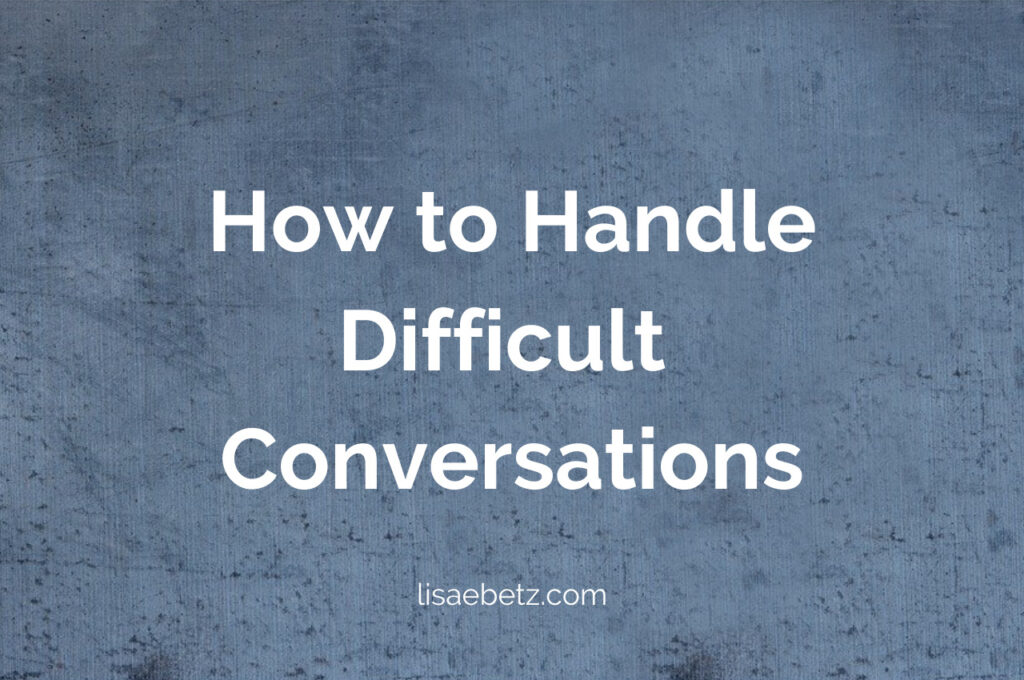
I am the sort of person who avoids conflict when possible. I don’t bring up hot-button topics. I let small annoyances slide rather than confronting someone about the problem. I don’t always come to the defense of a person or group being maligned in my hearing, because its easier to keep silent than to risk getting into an argument or making the situation more awkward than it already is.
But silence isn’t always the right answer. Living intentionally means we sometimes need to engage in difficult conversations or bring up topics it would be easier (but cowardly) to ignore. This post gives tips on how to handle those touchy conversations effectively.
The Who, What, and Where of tackling difficult conversations
Tough conversations are easier when we have a game plan to follow. These strategies will help you decide when it’s worth engaging and how to approach the conversation for the highest chance of success.
Who: consider your audience
On any given topic, you will generally find that people fall into three categories based on their opinions of the topic. At one end of the spectrum, there will be roughly 20% who generally agree with your position. When you discuss the topic with them, it’s like preaching to the choir. At the opposite end of the spectrum are roughly 20% who strongly disagree with you about the topic, and are not likely to change their opinions no matter what you say.
That leaves the (roughly) middle 60% who don’t have a terribly strong opinion of the subject and can thus be swayed by the groups on either side. Since the middle group doesn’t feel strongly about the topic, they probably aren’t saying much about it. But they are listening to the discussions between the opposing groups that are talking (or ranting) about it.

An Example: Let’s say we were discussing the superiority of cats as pets. If I hope to gain more supporters in my pro-cat beliefs, which group should I focus on? Those in the “choir” group don’t need persuasion. They already love cats. The “won’t budge” group aren’t going to change their anti-cat bias no matter how many cute kitten photos I show them. That leaves the middle group who might be willing to listen to my position and become more pro-cat.
So, when facing a difficult or touchy discussion, remember the 20/60/20 rule and consider which group the other person is in. If they’re in the middle group, there’s a good chance they will be receptive to a respectful discussion.
If they’re in the “won’t budge” group your discussion isn’t going to sway them, but you may be able to sway members of the middle group who are listening to the conversation. The trick is to state your case simply without getting into a pointless argument.
For example: “I understand you think dogs are the only pets worth having, but I want you to know that I and many others see things differently.” Statements like this show those listening that your position is just as valid as the one held by your stubborn opponent.
Why: consider your purpose
Why are you having this conversation? What do you hope to accomplish? How will you know if you’ve been successful?
Your decision to engage should be about more than simply winning the argument. Your goal will be different depending on which group of people you are engaging with. Are you trying to persuade a person to think differently? Stating a dissenting opinion for public record? Bringing up an opposing view so that those who are listening will consider your side of things?
Knowing your goal may let you “lose” the argument while succeeding in your actual purpose of challenging those listening in to think a little deeper.

Where and when: tact and timing
Is this something that is best discussed on the spot, or would it be wiser to pull someone aside later for a private chat? The answer to this question is tied to the who and why.
Is your main goal to gently help an individual see things differently, or ask a won’t-budger to kindly keep certain comments to herself? If so, a private talk may be best. On the other hand, an immediate response may be best if your goal is A) to let all who hear know the opinion just stated by someone else is not universally accepted of B) to state your public support for a group or individual under verbal attack.
What: use personal stories to draw them in
If you’re preaching to the choir, citing facts or statistics about the topic will interest them. If you’re speaking to the middle group (directly or indirectly) facts won’t move them nearly as well as stories or personal anecdotes.
If you want people to care about an issue, it’s more effective to use an individual’s story rather than speaking in generalities. We are much more likely to care about one person’s story of trauma than generalized reports about a larger group. The more you can get your audience to relate personally to the information, the better.
How: even if you’re preaching to the choir, don’t preach
Coming across as the expert dispensing wisdom to the unenlightened won’t win many converts. But staying quiet so you don’t look uninformed the moment someone asks a tough question isn’t going to help either.
Instead, stay real. Admit you are still learning about the topic, but here’s what you know so far… It’s OK to bring up a touchy topic without knowing all the answers. And you’ll get further in your persuasion if you allow for dialog and acknowledge the validity of other people’s questions and ideas.
I hope these tips help you the next time you face an awkward situation and aren’t sure whether to speak up or not.
